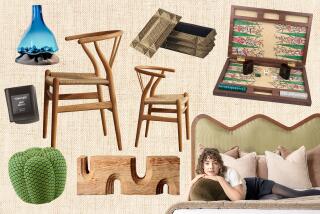Collectibles : Space-Saving Tables Have Roots in 17th Century
Space-saving furniture has been a necessity for centuries. In the 17th and early 18th centuries, the gateleg table was popular. A section of swinging table legs moved to hold up a leaf that enlarged the size of the tabletop. When the legs were folded in, the top was smaller, the table could be placed against a wall and it would take up less space.
By the 18th century, the drop-leaf table was designed. A single leg swung out to hold a leaf that dropped to the side of the table when it was not in use. Variations of the drop-leaf table were popular in the early 19th century. The Pembroke table was a small table with leaves that could be held in place on brackets.
The leaves were short: A drop-leaf dining table was three times as large when the leaves were used; a Pembroke breakfast table was twice as large when the small leaves were raised. By the mid-19th century, the table leaves were often hidden beneath the table or kept in a closet to be added when needed.
*
Question: I have started collecting American ceramic dinnerware from the mid-20th century. From reading, I learned about the âMid-Century Modernâ designs by Eva Zeisel and Russel Wright. I recently bought some fairly inexpensive but attractive Mikasa dishes that are marked âby Ben Seibel.â Who was he?
*
Answer: Ben Seibel (1918-85) is not as well-known as Zeisel and Wright, but his reputation among dinnerware collectors is growing. Seibel was born in Newark, N.J., and studied at the Pratt Institute in New York City at the same time Zeisel taught there. By the late 1940s, he had opened his own studio. He soon began to create designs for various American dinnerware manufacturers, including the Roseville Pottery and the Iroquois China Co. Sometime during the late 1960s or early â70s, Seibel started designing shapes for Mikasa, a Japanese company with U.S. headquarters in New Jersey. The extent of Seibelâs work for Mikasa will be better known now that his papers have been turned over to Syracuse University.
*
Q Among some postcards from the early 1900s, I found some loose stamps. They look like miniature versions of movie posters. Each stamp has a beautiful, color picture with a related title, like âJust for the Moviesâ and âSummer Breezes.â Thereâs no postage amount on the stamps. What were they used for?
*
A You have âposter stampsâ from about 1914. Poster stamps were first made in Europe in the 1890s. They never became as big a fad here as they were on the other side of the Atlantic. The American magazine Judge introduced them here in its July 1914 issue, which pictures stamps like those you describe. People were encouraged to collect the stamps, which sometimes advertised products or movies. The stamps could not be used as postage. Poster stamps, like old postcards, are popular with people who collect paper collectibles.
*
Q My grandfather saved old glass bottles. After he died, I found a notebook of information he had written down about most of the bottles. There are a few that he must not have been able to learn much about. One is an amber glass bottle that looks like it would hold a pint. The only clue is on the bottom. There is a small diamond with the word âCloroxâ inside. Did bleach once come in glass bottles?
*
A The Electro-Alkaline Co. (later the Clorox Co.) started selling Clorox-brand bleach in 1913. Clorox was first sold in 5-gallon crockery jugs to industrial users only. The company started marketing Clorox for home use in 1918. From 1918 to 1928, Clorox was sold for home use in unmarked, 15-ounce amber glass bottles. The bottle you describe, with the Clorox diamond trademark on the bottom, was used from 1929 to 1930. The company converted to white plastic bottles between 1960 and 1962.
*
Q My motherâs old doll is marked âAu Nain Bleu, E. Chauviere, Boul. des Capucines, 27 PARIS.â It has a bisque head, blond hair and a composition body, with joints at the hips, knees, shoulders and elbows. I assume the doll was made in France. What else can you tell me?
*
A Au Nain Bleu was a Paris store, founded in 1836 by Jean-Baptiste Chauviere. His son was named Edouard. It is probably his initial that is on your motherâs doll. The doll, called a âbebe,â is most likely from the late 1890s or the early 1900s. Look for other marks on the dollâs head and body. Au Nain Bleu also sold dolls made by other companies, including the German manufacturer Simon & Halbig. By the mid-1920s, Au Nain Bleu had moved from Boulevard des Capucines to 408 Rue St. Honore.
For a listing of helpful books and publications, include a self-addressed, stamped (55 cents) envelope to Kovels, Los Angeles Times, King Features Syndicate, 235 E. 45th St., New York, NY 10017.
(BEGIN TEXT OF INFOBOX / INFOGRAPHIC)
Current Prices
Current prices are recorded from antique shows, flea markets, sales and auctions throughout the United States. Prices vary in different locations because of local economic conditions.
* Smothers Brothers record, âIt Must Have Been Something I Said,â by Mercury Records, 1960s, $35.
* Souvenir matches from the Stork Club, 1940s, unused, $50.
* Pressed glass water tumbler, Big Button pattern, ruby stained, $55.
* National Biscuit Co. âUneeda Milk Biscuitâ tumbler, caramel slag, $130.
* Girl Scout lunch box, vinyl, metal thermos, 1960, $225.
* Sparton upright table radio, Junior model 410, wood, window dial, cutout grill, arched top, finials, footed, $270.
* Van Briggle bud vase, embossed dragonflies, burgundy matte glaze, 1915, marked and dated, 7 inches, $330.
* Jacquard 2-piece coverlet, floral design, weeping willow border, corner labeled âF.E. Hesse, Logan, Ohio 1859,â blue, red, gold and white, 37 1/2 by 86 inches, $880.


